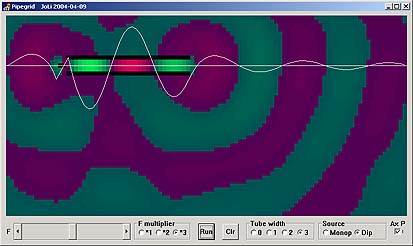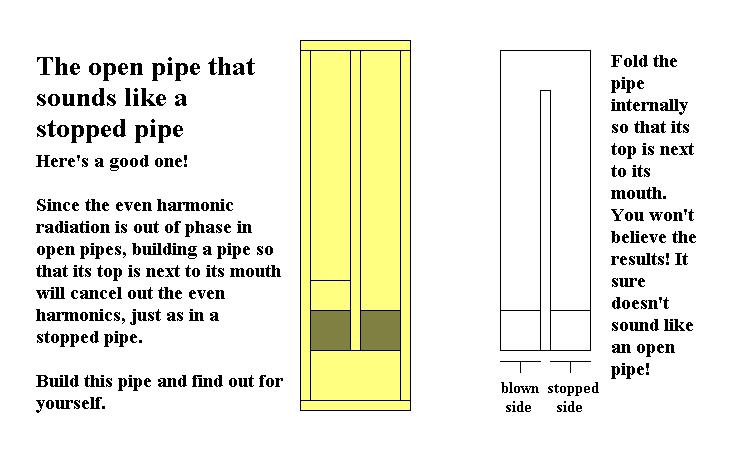
|
Subject:
Re: Effects of holes and slots in flue pipes. |
|
From:
Richard Weisenberger <rjweis00@yahoo.com> |
|
Date:
Fri, 2 Apr 2004 12:56:00 -0800 (PST) |
|
To:
KnudsenMJ@aol.com, MMD Pipes <mmd-pipes@foxtail.com> |
|
Subject:
Re: Effects of holes and slots in flue pipes. |
|
From:
Dave Goggin <dave65536@earthlink.net> |
|
Date:
Fri, 2 Apr 2004 13:03:59 -0800 (GMT-08:00) |
|
To:
mmd-pipes@foxtail.com |
|
Subject:
Re: Effects of holes and slots in flue pipes. |
|
From:
j.nolte@att.net |
|
Date:
Sat, 03 Apr 2004 00:07:43 +0000 |
|
To:
Richard Weisenberger <rjweis00@yahoo.com> |
|
CC:
KnudsenMJ@aol.com, MMD Pipes <mmd-pipes@foxtail.com> |
"Another way of getting a stopped pipe sound from an open pipe is to miter it in the center ...
I did this the easy way by cutting an old lead Diapason in half and inserting a short piece of flexible hose. Do a patent search for "Miter-matic." When the fundamental disappears as the top is brought close to the mouth, it can be brought back by inserting a piece of cardboard or plywood between them.
"This observed phenomenon is due to the fact that the fundamental and odd harmonics ...
Isn't it the other way?--the fundamental cancels as it is 180 degrees out of phase between the top and the mouth.
John
|
Subject:
Re: Effects of holes and slots in flue pipes. |
|
From:
Richard Weisenberger <rjweis00@yahoo.com> |
|
Date:
Fri, 2 Apr 2004 18:27:29 -0800 (PST) |
|
To:
j.nolte@att.net, MMD Pipes <mmd-pipes@foxtail.com> |
|
Subject:
Re: Effects of holes and slots in flue pipes. |
|
From:
KnudsenMJ@aol.com |
|
Date:
Fri, 2 Apr 2004 22:24:31 EST |
|
To:
j.nolte@att.net, rjweis00@yahoo.com |
|
CC:
mmd-pipes@foxtail.com |
Isn't it the other way?--the fundamental cancels as it is 180 degrees out ofphase between the top and the mouth.
Nope. If you visualize the air particles waving back in forth inside the
pipe, at the fundamental the pipe acts like two stopped pipes butted together at
their stopped ends, since the two standing quarter-waves "clap hands" in the
middle of the pipe. Each half radiates a positive pressure wave at the same
time. Same thing holds for the odd harmonics.
Even harmonics have a pressure antinode and flow node in the center, during
one half cycle the pressure in the center "loop" moves either upwards or
downwards, making the upper and lower "half pipes" 180 out of phase.
This implies that if you stand under an organ facade, the front pipes will
sound weak since the fundamental cancels out in your direction (along the pipe's
length) -- someone mentioned that. It also implies that when standing in
front of a small organ, with your ears halfway up the pipe height, the even
harmonics should cancel out the same as when the pipe is bent around on itself.
I guess we don't notice that, thanks to sound reflections and dispersions.
We don't listen to organ pipes in anechoic chambers, though I've been in
churches that sure tried :-( --Mike K.
|
Subject:
Re: Effects of holes and slots in flue pipes. |
|
From:
Johan Liljencrants <johan@fonema.se> |
|
Date:
Sat, 03 Apr 2004 21:45:52 +0200 |
|
To:
mmd-pipes@foxtail.com |
The sound of that note is well-known to be 'odd' or 'harsh' inOn my recorder I fail to notice any different timbre leaving only the lowest hole open. On the other hand I don't understand the recorder at all from another aspect. Mine is very timid in terms of sound volume. Very contrary to my impression of professionals playing concert pieces. Is this a matter of a deficient player or a deficient instrument?
comparison to neighboring notes ...
|
Subject:
Re: Effects of holes and slots in flue pipes. |
|
From:
j.nolte@att.net |
|
Date:
Sat, 03 Apr 2004 20:47:11 +0000 |
|
To:
Johan Liljencrants <johan@fonema.se> |
|
Subject:
Re: Effects of holes and slots in flue pipes. |
|
From:
Richard Weisenberger <rjweis00@yahoo.com> |
|
Date:
Sat, 3 Apr 2004 18:31:51 -0800 (PST) |
|
To:
Johan Liljencrants <johan@fonema.se>, MMD Pipes
<mmd-pipes@foxtail.com> |
|
Subject:
Re: Effects of holes and slots in flue pipes. |
|
From:
j.nolte@att.net |
|
Date:
Mon, 05 Apr 2004 11:48:20 +0000 |
|
To:
Johan Liljencrants <johan@fonema.se> |
|
CC:
mmd-pipes@foxtail.com, |
|
Subject:
Re: Effects of holes and slots in flue pipes. |
|
From:
Richard Weisenberger <rjweis00@yahoo.com> |
|
Date:
Mon, 5 Apr 2004 06:21:00 -0700 (PDT) |
|
To:
j.nolte@att.net, MMD Pipes <mmd-pipes@foxtail.com> |

|
Subject:
Re: Effects of holes and slots in flue pipes. |
|
From:
Dave Goggin <dave65536@earthlink.net> |
|
Date:
Mon, 5 Apr 2004 10:06:26 -0700 (GMT-07:00) |
|
To:
mmd-pipes@foxtail.com |
and the fundamental, as well as the even harmonics, are cancelled. The pipe overblows, it does not turn into a >stopped pipe.
You have checked it on your spectrum analyzer?
I'm not sure why the fundamental should cancel but the other odd harmonics not. But I am willing to believe that the thing overblows just like a stopped pipe of comparable pitch would.
By the way: I thought of a possible explanation for why slots might increase harmonic content: Perhaps the slot is increasing the radiating area for the sound waves coming off the pipe top and hence giving a better impedence match with the atmosphere something like a flared bell. And that usually makes the higher harmonics sound stronger from outside the pipe.
DG
|
Subject:
Re: Effects of holes and slots in flue pipes. |
|
From:
Richard Weisenberger <rjweis00@yahoo.com> |
|
Date:
Mon, 5 Apr 2004 10:53:16 -0700 (PDT) |
|
To:
Dave Goggin <dave65536@earthlink.net>, MMD Pipes
<mmd-pipes@foxtail.com> |
|
Subject:
Re: Effects of holes and slots in flue pipes. |
|
From:
Richard Weisenberger <rjweis00@yahoo.com> |
|
Date:
Mon, 5 Apr 2004 11:17:22 -0700 (PDT) |
|
To:
Dave Goggin <dave65536@earthlink.net>, MMD Pipes
<mmd-pipes@foxtail.com> |
|
Subject:
Dumbfounding double folding |
|
From:
Johan Liljencrants <johan@fonema.se> |
|
Date:
Tue, 06 Apr 2004 00:21:29 +0200 |
|
To:
mmd-pipes@foxtail.com |
|
Subject:
Re: Dumbfounding double folding |
|
From:
Richard Weisenberger <rjweis00@yahoo.com> |
|
Date:
Mon, 5 Apr 2004 18:30:37 -0700 (PDT) |
|
To:
Johan Liljencrants <johan@fonema.se>, MMD Pipes
<mmd-pipes@foxtail.com> |
|
Subject:
Re: Dumbfounding double folding |
|
From:
Dave Goggin <dave65536@earthlink.net> |
|
Date:
Mon, 5 Apr 2004 18:54:53 -0700 (GMT-07:00) |
|
To:
mmd-pipes@foxtail.com |
|
Subject:
Double folded open pipe - power spectrum |
|
From:
Robbie Rhodes <rrhodes@linkline.com> |
|
Date:
Mon, 05 Apr 2004 19:10:51 -0700 |
|
To:
MMD Pipes <mmd-pipes@foxtail.com> |
|
CC:
Robbie Rhodes <rrhodes@linkline.com> |
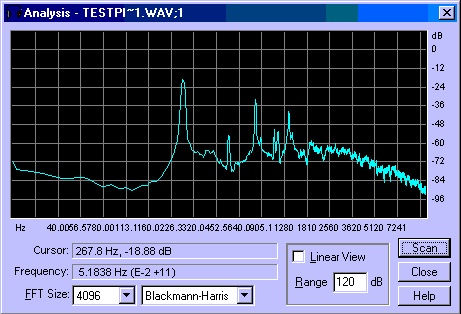
|
Subject:
Re: Dumbfounding double folding |
|
From:
j.nolte@att.net |
|
Date:
Tue, 06 Apr 2004 03:04:40 +0000 |
|
To:
Johan Liljencrants <johan@fonema.se> |
|
CC:
mmd-pipes@foxtail.com, |
I did a couple more tests today to verify what I have been writing. My original test pipe is a round metal Diapason cut in half and rejoined by a flexible wire- reinforced hose. Blowing it in the straight position, it is about 700mm long and about 2 1/4" in diameter. It nominally plays a G# at about 200hz. Some trombone like tuming is possible by stretching or compressing the flexible portion. I had the hose section connected with hose clamps, but just in case there was some leakage in the joints I taped them with vinyl electrical tape. The original test pipe is slotted at the top with the slot almost as long as the diameter. When the tuning slot is brought near the mouth, the pipe overblows to the octave, nominally a G# at about 400 hz.
For clarification we should be should be sure we are numbering harmonics the same way. I prefer to call the fundamental the first harmonic, the octave the second harmonic, the quint the third harmonic, etc. Thus the frequency of the harmonic is its number times the fundamental.
Since the flexible part of the pipe allows the end to be moved around in relation to the mouth, several things could be observed. It is possible to place the open end of the pipe near the mouth with very little difference in the tone quality. There is a definite geometric shape in which the fundamental cancels and only the octave can be heard (as well as overtones, but without fundamental at all). The octave becomes stronger as the slot is moved up and out from the mouth by about 20-30* from the horizontal. There is a definite maximum at a specific distance. Move it closer or further and the intensity changes quite a bit. This maximum also extends in an arc above the mouth in front of the pipe down and around towards the side. Again, the distance from the mouth is critical for the maximum effect.
I made another test pipe from the pipe in this set that is about an octave higher. For this one I cut the pipe off above the mouth and attached a paper and foil flexible tube about 1-1/4" dia like the pipe. This pipe also plays a nominal G# an octave higher then the first. It is harder to get the same results, in part I think because the top of the tube is cut off straight. When it is bent all the way around so it opens right into the mouth, the fundamental cancels, and it overblows to the octave. In other orientations, the pipe becomes unsteady and warbles between the fundamental and the octave. There are other places where the tone only changes a little if at all. I added the slotted section to the tube, but it becomes almost too long and wants to overblow from blowing pressure alone.
I have a wooden pipe for the bass of a monkey organ that is mitered sideways like Richard's. It is a little short of the mouth, and since it is normally stopped, I never worried about interference. I have some cutoffs that I can cobble to the end to make something like Richard's, but not before Easter--we are a little busy now.
Based on the .wav file Richard sent, his pipe overblows to the octave. If it were a stopped pipe, or had the harmonic structure of a stopped pipe, it should over blow to the quint. I believe it sounds fluty (technical term for lacking overtones) not because it has the overtones of a stopped pipe, but because the cutup is high enough to minimize all overtone structure. The fact that it cannot easily be overblown to eliminate the fundamental illustrates this further. I have some very large scale pipes that can only be overblown if you are willing to risk hyperventillation. In foot nomenclature, an 8' open pipe overblows to 4', while an 8' stopped pipe overblows to 2 2/3'. I have a stop of overblown and double overblown stopped pipes that play the 2 2/3' and 1-3/5' . My experience with being able to move the open end of my test pipe suggests that location of the open end in relation to the mouth is critical to achieve cancellation of the fundamental. Then it is not hard to make the pipe overblow. In fact, it is impossible for it not to. When the pipe is straight, it overblows to the same note as it goes to when the cancellation occurs. Making rigid samples may take way too many pipes to be practical if you want to consider all of the possibilities. There is no reason a flexible hose can't join two pieces of a wood pipe. If I do Richard's version, I would also make the same size in a straight version.
--
John
|
Subject:
Re: Dumbfounding double folding |
|
From:
j.nolte@att.net |
|
Date:
Tue, 06 Apr 2004 03:21:25 +0000 |
|
To:
Dave Goggin <dave65536@earthlink.net> |
|
CC:
mmd-pipes@foxtail.com |
The patent number for the miter-matic pipe with the flexible insert is:
=?ISO-8859-1?Q?Re:=20=A0=20=A0=20=A0=20Got!=20cha=20I =?ISO-8859-1?Q?think=20?=
--
John
ps: My people will contact yuour people to work out a licensing agreement.
|
Subject:
Re: Dumbfounding double folding |
|
From:
KnudsenMJ@aol.com |
|
Date:
Mon, 5 Apr 2004 23:43:39 EDT |
|
To:
johan@fonema.se |
|
CC:
mmd-pipes@foxtail.com |
For clarification we should be should be sure we are numbering harmonics the same way..
I agree Johan, I've always numbered the harmonics that way.
Some people agree that when they say "overtone" or "partial" instead of
"harmonic", it means that "the Nth parial/overtone" is the "N+1st harmonic) or
(N+1)xfundamental.
Now back to figuring out these twisted pipes ... Mike K.
|
Subject:
Re: Dumbfounding double folding |
|
From:
KnudsenMJ@aol.com |
|
Date:
Mon, 5 Apr 2004 23:43:40 EDT |
|
To:
johan@fonema.se |
|
CC:
mmd-pipes@foxtail.com |
j.nolte:When the tuning slot is brought near the mouth, the pipe overblows ...
Well, this is disappointing, the pipe overblows instead of hanging on to the
fundamental and canceling out even harmonics.
However, now that I see this, I think it can be explained and could have been
predicted.
We know that if you put two similar pipes of the same pitch very close to
each other and blow both, you get a weak, emasculated tone that's much less than
either pipe alone, let alone the sum of the two. The reason is that the pipes
phase-lock to each other, but in what they perceive as a cooperative way,
with one pipe's mouth blowing out while the other blows in, and vice-versa for
each cycle of the fundamental. That is, both pipes don't try to blow out or in
at the same time.
In this way, the two pipes help each other play -- but from our viewpoint,
much less fundamental sound escapes for our ears to enjoy.
Now given that Nature will have pipes "cooperate" that way, imagine bending
an open pipe's end around towards its mouth. We've already established that at
the fundamental and odd harmonics, the two ends are in phase. But
"cooperation" wants them out of phase, one sucking while the other blows. That's what
the 2nd harmonic (octave) will do, so the pipe overblows to the octave, in the
name of cooperation.
(Cue the old joke about the earthworm falling in love with his/her other end.
They are hermaphroditic, so it might work...)
And I'll bet that even that octave sound is pretty wimpy.
I'm beginning to think that the reason no really new organ stops have been
invented since Praetorious is not our fault, but those damned laws of physics.
There goes the reedless krummhorn. --Mike K.
|
Subject:
Re: Effects of holes and slots in flue pipes. |
|
From:
KnudsenMJ@aol.com |
|
Date:
Mon, 5 Apr 2004 23:43:41 EDT |
|
To:
mmd-pipes@foxtail.com |
4/5/04 1:53:29 PM rjweis00:The polar patterns of open pipes are quite analogous ...
Yep, on my last posting I almost said something about how my Ham radio
training finally paid off. Been K(N)3JVK, N9NRD, AA9RG, and now AA1UK.
I run a dipole fed at 1/3 its length instead of the middle. Lots of fun
drawing standing wave patterns to figure out why it loads on all bands (well, not
those WARC bands, I mean the real ham bands that vacuum tube gear operates :-)
--Mike K.
|
Subject:
Re: Effects of holes and slots in flue pipes. |
|
From:
KnudsenMJ@aol.com |
|
Date:
Mon, 5 Apr 2004 23:43:41 EDT |
|
To:
mmd-pipes@foxtail.com |
> 4/5/04 dave65536:By the way: I thought of a possible explanation for why slots might ...
ISTR hearing that the end-effect length correction of a pipe is something
like the pipe diameter times some function of the wavelength, so for a wide pipe
the effective length of the pipe is different for the higher harmonics than
for the fundamental. Consequently the pipe is "out of tune" with the upper
partials, and they are suppressed for a flutey tone.
In a narrow pipe the end correction is more alike for all harmonics, so the
upper partials can shine.
Now, ISTR a tuning slot creates a leak that makes the pipe look shorter for
the higher harmonics, thus bringing them into tune even for a wider pipe. Or
maybe it's the reverse. But I definitely recall that a slot has more effect on
higher harmonics than low ones -- or the reverse. Been a while since I read
the organ mags in the college library (and most of the theories back then were
ridiculously wrong, anyway :-) --Mike K.
|
Subject:
Re: double folding and other things. |
|
From:
Dave Goggin <dave65536@earthlink.net> |
|
Date:
Mon, 5 Apr 2004 23:34:50 -0700 (GMT-07:00) |
|
To:
KnudsenMJ@aol.com |
|
CC:
mmd-pipes@foxtail.com |
I'm beginning to think that the reason no really new organ stops have been
invented since Praetorious is not our fault, but those damned laws of physics.
There goes the reedless krummhorn. --Mike K.
Hi Mike,
Well, we still haven't disproven your node hole method. And in fact perhaps a wood string made in the form of Richard's pipe might yet work out.
Actually the whole family of skinny strings was unknown in Pretorius' time.
Got more clues on the slot thing today. Apparently longer slots are better and more effective. Not sure how far one can go with that though.
If one is ever able to manage a reedless krummhorn, then the next step would be a reedless vowel pipe. I opened my "world championships of Flue Pipe making" 4 years ago and still no one has submitted an attempt to duplicate the target timbre, http://home.earthlink.net/~dave65536/voice_ah.wav [dead link]
DG
|
Subject:
Re: Dumbfounding double folding |
|
From:
Richard Weisenberger <rjweis00@yahoo.com> |
|
Date:
Tue, 6 Apr 2004 05:41:05 -0700 (PDT) |
|
To:
KnudsenMJ@aol.com, MMD Pipes <mmd-pipes@foxtail.com> |
|
Subject:
Re: Dumbfounding double folding |
|
From:
j.nolte@att.net |
|
Date:
Tue, 06 Apr 2004 17:55:51 +0000 |
|
To:
KnudsenMJ@aol.com |
|
CC:
johan@fonema.se, mmd-pipes@foxtail.com |
Pipers: When I wrote:When the tuning slot is brought near the mouth, the pipe overblows ...
M. Knudsen replied:Well, this is disappointing, the pipe overblows instead of hanging on ...
Followed by conjecture outside the realm of experience.
Followed by: And I'll bet that even that octave sound is pretty wimpy.
How much will you bet? I'll give you 10:1 on anything up to $1,000,000. I'm beginning to think that the reason no really new organ stops have been invented ...
Or it could be that those guys were as smart as we are after all--
and then they were born first.
Based on the .wav file and my experience, I have concluded that Richard's pipe does
not exhibit the harmonic spectrum of a stopped pipe, and that there is virtually
no cancellation of either the odd or even harmonic series taking place.
To test for interference, a straight control pipe should also be constructed and
voiced in the same way as the folded pipe.
I'll be doing some drawings later to illustrate what happens and why. What happens
is that the first (fundamental) and all successive odd harmonics are cancelled
because at the mouth they are in opposite phase from the open end of the pipe. The
even series is reinforced. Those are the facts. They are not disappointing, they
are interesting, and theory to the contrary is wrong (although the flow at the bottom
of the column is in phase with the flow at the top).
I'll also suggest a few possible pipe constructions to test some theories. Now I
have to discipline myself to finish the Gedeckt that my wife wants to play on Easter.
John
|
Subject:
Re: Dumbfounding double folding |
|
From:
Richard Weisenberger <rjweis00@yahoo.com> |
|
Date:
Tue, 6 Apr 2004 11:45:28 -0700 (PDT) |
|
To:
j.nolte@att.net, MMD Pipes <mmd-pipes@foxtail.com> |
|
Subject:
Re: Dumbfounding double folding |
|
From:
j.nolte@att.net |
|
Date:
Tue, 06 Apr 2004 20:11:02 +0000 |
|
To:
Richard Weisenberger <rjweis00@yahoo.com> |
|
CC:
MMD Pipes <mmd-pipes@foxtail.com> |
Richard and pipers:
On my pipe it is the fundamental and odd harmonics that are being cancelled. Robbie's analysis is not of my pipe. In your .wav file first you play the fundamental, and then you overblow the pipe. When you overblow it, it overblows to the second (octave), not the third (quint)harmonic. Granted, the second harmonic is weak, and it does not overblow to it cleanly to eliminate the fundamental. If it had the harmonic characteristics of a stopped pipe, it would overblow to the third harmonic, but it does not.
--
John
|
Subject:
Re: Dumbfounding double folding |
|
From:
Richard Weisenberger <rjweis00@yahoo.com> |
|
Date:
Tue, 6 Apr 2004 13:57:40 -0700 (PDT) |
|
To:
j.nolte@att.net, MMD Pipes <mmd-pipes@foxtail.com> |
|
Subject:
Double folded results |
|
From:
Johan Liljencrants <johan@fonema.se> |
|
Date:
Tue, 06 Apr 2004 23:14:09 +0200 |
|
To:
MMD Pipes <mmd-pipes@foxtail.com> |


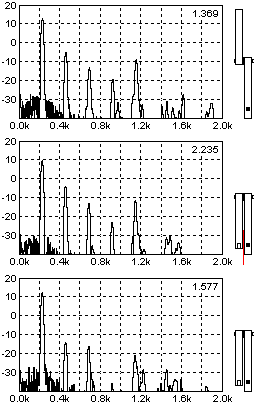
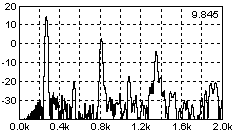
|
Subject:
Re: Dumbfounding double folding |
|
From:
KnudsenMJ@aol.com |
|
Date:
Tue, 6 Apr 2004 23:39:12 EDT |
|
To:
j.nolte@att.net |
|
CC:
mmd-pipes@foxtail.com |
Sorry if I offended anyone with my off-the-cuff theorizing. But things
really are confusing right now. As someone else mentioned, there were two
different sets of results posted. The WAV file definitely backed up the original
idea, that a folded pipe would sound like a stopped pipe, and the posted FFTs
proved it. I think that WAV was form Richard W. But someone else said their test
pipe just overblew, and that's what I theorized about.
Now Johan has gotten results in between, with his reconfigurable miter joint.
None of his MP3 files seem to indicate success in suppressing the even
harmonics, and I agree with him that the speech of the pipe is not good enough for
practical use.
Maybe there are some tricks to doing this so that it works as hoped. Perhaps
it is like Haskell pipes -- theory doesn't quite explain them, and they are
tricky to voice and tune. BTW, Haskell should send me a jug of ketchup to help
me eat my words about "nothing new since Praetorius." Haskell pipes were a
great practical advance. I have a rank of Haskell salicionals here, and a
friend has a rank of them playing in his living room. I tried making one of my
own and got nowhere.
--Mike K.
|
Subject:
Re: Double folded results |
|
From:
"John D. Rhodes" <jrhodes@pacifier.com> |
|
Date:
Tue, 6 Apr 2004 21:21:07 -0700 |
|
To:
"Johan Liljencrants" <johan@fonema.se> |
|
CC:
"Mike Knudsen" <KnudsenMJ@aol.com> |
I wonder if the double-mitre is creating an impedence discontunity at the _midpoint_ of the pipe.
This might affect some harmonics more than others.
John Rhodes
(AA7HL)
Vancouver, WA
|
Subject:
Re: Dumbfounding double folding |
|
From:
Richard Weisenberger <rjweis00@yahoo.com> |
|
Date:
Wed, 7 Apr 2004 06:29:59 -0700 (PDT) |
|
To:
KnudsenMJ@aol.com, MMD Pipes <mmd-pipes@foxtail.com> |
|
Subject:
Re: Dumbfounding double folding |
|
From:
j.nolte@att.net |
|
Date:
Wed, 07 Apr 2004 14:14:00 +0000 |
|
To:
Richard Weisenberger <rjweis00@yahoo.com> |
|
CC:
KnudsenMJ@aol.com, MMD Pipes <mmd-pipes@foxtail.com> |
This whole thing is really turning out to be a learning experience for all of us, myself included.
I guess that is the point of this forum. I hope the give and take which sometimes on my part can be caustic is understood as being good natured pursuit of knowledge, with maybe a little of arrogance needed to argue a point to the test.
Next I want to learn what is a good program for recording and analyzing sound on my computer. I have a recent Toshiba laptop running windows xp. Yesterday I was going to plug a mike into the side of it a record a sample, but all I have on it is the windows media player, and the basic Real One which freezes up everytime I open it. Freeware, shareware, or something under $100 is what I am looking for.
I might have drawings today, but the essence of my theory is that the jet drive mechanism that creates a pressure high just above the upper lip to create upward flow also creates outward flow through the mouth. Meanwhile, at the other end of the pipe in resonance, the pressure low is causing flow into the top of the pipe. When the outward flow at the mouth (or the vortex shedding, or pressure high, or the voicer magic) is sufficient, the jet is forced outside the pipe and creates a pressure low just above the lip, pulling down on the air column causing outward flow. Meanwhile at the other end, the pressure has gone high, also causing outward flow. The same low pressure pulling down on bottom of the air column is also pulling in through the mouth. In effect, the mouth and the base of the air column are in opposite phase.
--
John
|
Subject:
2nd Harmonic Suppression or Not? |
|
From:
Richard Weisenberger <rjweis00@yahoo.com> |
|
Date:
Wed, 7 Apr 2004 09:21:14 -0700 (PDT) |
|
To:
MMD Pipes <mmd-pipes@foxtail.com>, Johan Liljencrants
<johan@fonema.se> |
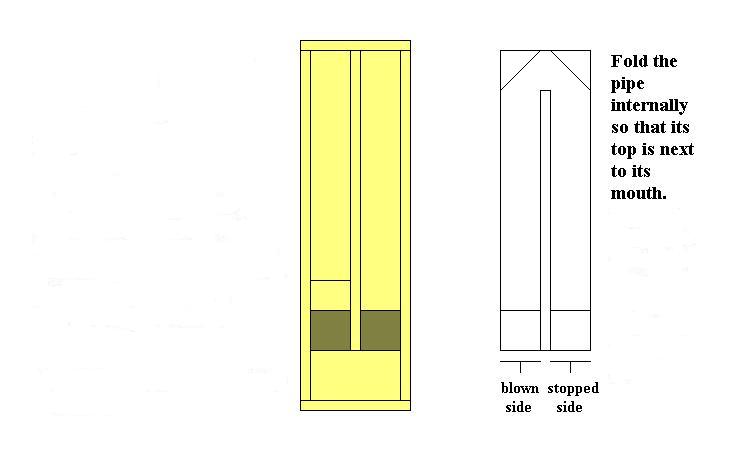
|
Subject:
Re: 2nd Harmonic Suppression or Not? |
|
From:
j.nolte@att.net |
|
Date:
Wed, 07 Apr 2004 18:50:46 +0000 |
|
To:
Richard Weisenberger <rjweis00@yahoo.com> |
|
CC:
MMD Pipes <mmd-pipes@foxtail.com>, Johan Liljencrants
<johan@fonema.se>, |
Here's a bad recording of my test pipe. It starts with the pipe blowing in the normally upright position, and then I move the top of the slotted pipe down near the mouth. Moving it around after the fundamental cancels strengthens or weakens the dominant second harmonic, and sometimes there is a warbling as the interference is on the edge of the right location for cancelling. The microphone is one that originally came with a computer probably just for voice.
John
Testmitermatic.wav
|
Subject:
Re: 2nd Harmonic Suppression or Not? |
|
From:
Richard Weisenberger <rjweis00@yahoo.com> |
|
Date:
Wed, 7 Apr 2004 12:59:49 -0700 (PDT) |
|
To:
j.nolte@att.net, MMD Pipes <mmd-pipes@foxtail.com> |
|
Subject:
Re: 2nd Harmonic Suppression or Not? |
|
From:
j.nolte@att.net |
|
Date:
Wed, 07 Apr 2004 20:45:40 +0000 |
|
To:
Richard Weisenberger <rjweis00@yahoo.com> |
|
CC:
MMD Pipes <mmd-pipes@foxtail.com> |
The pipe has a wire re-inforced section in the middle. Everything there is air tight. The flexible tube does not collapse.
The purpose of making the pipe was to demonstrate that out of phase harmonics are of equal strength and will cancel when the top and mouth are brought together.
As I mentioned in an earlier post, I made a similar pipe an octave higher with just a flexible paper and foil tube. It behaved about the same, but it was more difficult to align the top and mouth to effect cancellation. I cut a slot in the paper tube (just a rectangular hole a little ways down the tube) and that can be directed at the mouth for better results.
There is a very definite pattern of sound radiation from the slot and the mouth, and a very definite map of locations where cancellation occurs. On this approximately 700mm long pipe, cancelation occurs when the slot is right in front of the mouth, and it can be moved up and out at about 30* to about a foot away and still cancel the fundamental. The slot is cut down from the top of the pipe, so there is no leakage.
I do not think of any of the results as problems. The main purpose of the experiment is to demonstrate that it is the fundamental that cancels when the top of the pipe interacts with the mouth.
"No laws of physics were broken in this demonstration." Or were they?
If I do any more recordings, I will try to get a better mike, and keep it to five seconds or less. I noticed the 1.x mb file size after I clicked send.
--
John
|
Subject:
Re: 2nd Harmonic Suppression or Not? |
|
From:
Richard Weisenberger <rjweis00@yahoo.com> |
|
Date:
Wed, 7 Apr 2004 14:10:54 -0700 (PDT) |
|
To:
j.nolte@att.net, MMD Pipes <mmd-pipes@foxtail.com> |
|
Subject:
Re: 2nd Harmonic Suppression or Not? |
|
From:
Johan Liljencrants <johan@fonema.se> |
|
Date:
Wed, 07 Apr 2004 23:48:11 +0200 |
|
To:
j.nolte@att.net |
|
CC:
Richard Weisenberger <rjweis00@yahoo.com>, MMD Pipes
<mmd-pipes@foxtail.com> |
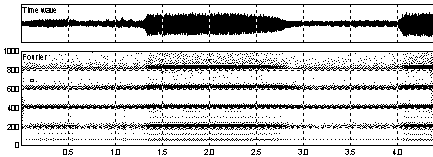
|
Subject:
Re: 2nd Harmonic Suppression or Not? |
|
From:
j.nolte@att.net |
|
Date:
Wed, 07 Apr 2004 22:08:16 +0000 |
|
To:
Johan Liljencrants <johan@fonema.se> |
|
CC:
Richard Weisenberger <rjweis00@yahoo.com>, MMD Pipes
<mmd-pipes@foxtail.com> |
By high and low pressures, I am referring to the compressions and rarefractions of the sound wave emitting from the pipe. In the same way, I would say a speaker cone moving into the room is creating high pressure, while the same cone, or another part of it moving away from the room is creating low pressure. More intuitive than rigorously theoretical.
A drawing of my theory (less than 1.7 mb) is attached. The explanation of the drawing is:
The drawing at the left shows acoustic flow up at the mouth
and down at the top of the pipe air column in oscillation for the
fundamental frequency.
The next drawing shows the jet creating high pressure which
causes the upward flow. At the same time in the standing wave,
low pressure at the top causes flow down. At both ends of the
column, the flow is into the column and acoustically in phase
according to accepted theory.
The next drawing adds the mouth opening and shows the flow
coming out of the mouth because of the same jet induced high
pressure. This mechanism reverses the acoustic phase at the
mouth from the phase at the bottom of the air column.
When the high pressure/outward flow forces the jet out of the
pipe, the jet creates a low pressure causing downward flow at
the end of the column, and inward flow at the mouth. The standing
wave high pressure has reversed the flow at the top.
The result, verified experimentally, is that the top of the pipe and the
mouth are in opposite phase for the fundamental, so that when mitered
around to create interference, the fundamental cancels.
--
John
|
Subject:
1st Harmonic Suppression Range |
|
From:
j.nolte@att.net |
|
Date:
Wed, 07 Apr 2004 22:32:00 +0000 |
|
To:
Johan Liljencrants <johan@fonema.se> |
|
CC:
MMD Pipes <mmd-pipes@foxtail.com> |
The nature of the flexible tube and segment lengths prevents trying the same thing below the mouth. I was able to rotate the slot around the pipe about 1/4 turn before the pipe couldn't be manipulated any further. The range in the drawing can be rotated that far with the same results. The implication for various rigid folded pipes is that the opening--preferrably a slot at the top of the pipe--has to be located very precisely relative to the mouth for this phenomenon to be observed. Perhaps a short flexible tube could be appended to a rigid pipe.
--
John
|
Subject:
Re: 2nd Harmonic Suppression or Not? |
|
From:
Richard Weisenberger <rjweis00@yahoo.com> |
|
Date:
Wed, 7 Apr 2004 18:45:44 -0700 (PDT) |
|
To:
Johan Liljencrants <johan@fonema.se> |
|
Subject:
Re: 2nd Harmonic Suppression or Not? |
|
From:
Dave Goggin <dave65536@earthlink.net> |
|
Date:
Wed, 7 Apr 2004 21:58:51 -0700 (GMT-07:00) |
|
To:
mmd-pipes@foxtail.com |
So it seems then that the folded pipe should be expected to cancel its fundamental, because at the moment there is a compression at the mouth at the fundamental, there is a rarefaction at the far end. When they are brought together they cancel. The mouth overpressure pushes out and the other end underpressure sucks in? They should only reinfoce the even harmonics i.e. overblow??
DG
|
Subject:
Re: 2nd Harmonic Suppression or Not? |
|
From:
j.nolte@att.net |
|
Date:
Thu, 08 Apr 2004 11:35:02 +0000 |
|
To:
Dave Goggin <dave65536@earthlink.net> |
|
CC:
mmd-pipes@foxtail.com |
Dave started us on this thread by asking about slots. For the experiments I am doing, the slot helps a lot so that I can focus the open end on the mouth. It seems to me that when the slot is large enough, probably at least as large as the mouth, most of the coupling of the pipe to the air at the top happens through the slot. When tuning slotted pipes, if the slot is down a ways and does not go all the way to the top of the pipe, shading the top of the pipe has very little effect on the pitch of the pipe, so for efficiency, the tuner shades the slot to hear which way the pitch moves as the pipe is flsattened. On strings, focusing the sound out of a slot in the top may be affecting the timbre by creating just a little cancellation of some of the odd harmonics.
For those of you who want to play with a flexible pipe, I have more pipes in this set that could have no higher purpose. The largest is about 3" in diameter. The smaller pipes--1-1/4" or less are harder to use because the body length is too short to manipulate. Check your local hardware or autoparts store for flexible hoses in the 1-1/2"-3" range and let me know what you need. Your local organ builder or service man will probably also have a supply of old pipes. Don't ask him to break up a good set.
Since lower pitches are better proportioned for these experiments, we are offering a one time sale of 32' open wood pipes with a flexible accordion couplings in your choice of wood and finish for only $12,000 each, fob Milwaukee. Discounts on orders of 10 or more.
Actually, we have made a sawed off sample 16' stopped pipe that can be fitted with a collar for an 8" pvc pipe resonator with a little flex inserted to make the end movable. Ours has an adjustable upper lip, and can be fited with an adjustable flue as well. I'll probably do this before next October's organ builders convention.
--
John
|
Subject:
Re: 2nd Harmonic Suppression or Not? |
|
From:
Richard Weisenberger <rjweis00@yahoo.com> |
|
Date:
Thu, 8 Apr 2004 06:25:51 -0700 (PDT) |
|
To:
Dave Goggin <dave65536@earthlink.net>, MMD Pipes
<mmd-pipes@foxtail.com> |
I am still curious, however, as to why Johan's pipe didn't seem to have the same degree of even harmonic cancellation as mine. Until I hear differently, I'm attributing this to the fact that my pipe used no internal deflectors to acoustically straighten the path. I believe it is the internal reflections between parallel walls of an open pipe (half wave radiator) folded in half that are cancelling the even harmonics in my pipe. I believe these internal reflections of the even harmonics to be out of phase.
If what David is saying were true, you would also expect the back wave of a woofer to be out of phase with the front wave in a ported speaker design, since this is logical. Both measurements and the ear show that in fact they are additive and in phase over a given bandwidth.
Whenever there is a conflict between a long held belief and an
observed fact, you always need to put real world observations and
measurements over simple logic. If we didn't, cosmologists would
still
be using Newtonian physics, which seems to fit well under normal
everyday circumstances. Whenever we push the envelope, there are always
exceptions to the rule.
|
Subject:
Flexible pipes |
|
From:
Craig Smith <craigsmith@sprintmail.com> |
|
Date:
Thu, 08 Apr 2004 10:55:24 -0400 |
|
To:
mmd-pipes@foxtail.com |
|
Subject:
Re: 2nd Harmonic Suppression or Not? |
|
From:
Dave Goggin <dave65536@earthlink.net> |
|
Date:
Thu, 8 Apr 2004 10:25:28 -0700 (GMT-07:00) |
|
To:
mmd-pipes@foxtail.com |
And for my part I would like to return to that topic, seeing how the discussion has wandered off into a swamp with the bent and flexible pipe discussion. My only interest in it is if you can make a reedless clarinet out of it which apparently you can't do.
It is said that a longer slot and a larger amount of regular pipe above the slot contribute most to the effect. I'd rather see the pipes forum experimenting with that than going on this wild goose chase after the bent pipe.
If there are more spare pipes laying around let's study the effect of slotting and set aside the bent pipe issue because even if the claimed effect occurs it is not practical as a real pipe.
DG
|
Subject:
Re: Flexible pipes |
|
From:
Johan Liljencrants <johan@fonema.se> |
|
Date:
Fri, 09 Apr 2004 15:51:28 +0200 |
|
To:
mmd-pipes@foxtail.com |
|
Subject:
Hole Suppression |
|
From:
Johan Liljencrants <johan@fonema.se> |
|
Date:
Fri, 09 Apr 2004 19:08:14 +0200 |
|
To:
MMD Pipes <mmd-pipes@foxtail.com> |
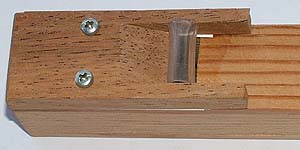
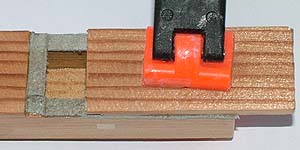
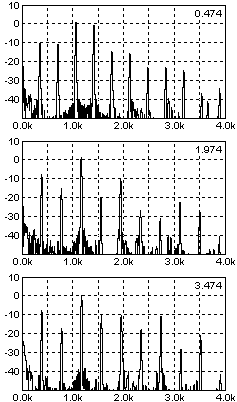
|
Subject:
Re: Hole Suppression |
|
From:
Dave Goggin <dave65536@earthlink.net> |
|
Date:
Fri, 9 Apr 2004 11:56:57 -0700 (GMT-07:00) |
|
To:
mmd-pipes@foxtail.com |
Thanks Professor Johan, wow that is quite remarkable. In fact, sound #3 does have a certain 'hornlike' quality, yet even though some even harmonics are weak 2 and 3 don't sound to my ears like a stopped pipe. It's also unclear to me why any even harmonics should get reduced at all!
A particular feature is case 2 where there is a some 60 mm long open tube ...
This at least is consistent with the description of "hornlike" insofar as an orchestral horn (think flugelhorn) actually has its spectrum drop off quite rapidly above 2 kHz. But! It is #3 that seems more hornlike, not #2 with the 2.8 kHz valley in the spectrum. But perhaps my ear is reacting to the fact that the strongest harmonic in #3 is around 1300Hz, exactly where the formant peak is in e.g. a cornet. ?? puzzling.
Since the 'extra resonator' implicity attached to the top of the pipe in this case is an open one, it should simply transmit its input from one end to the other... or am I not understanding how open-pipe (as opposed to closed-pipe) resonators work??
Now we have another puzzle for the pipes forum to banter back and forth about. On another list it was posted that strings are typically slotted with the slot width about 2/7 the diameter of the pipe and starting about 1 pipe diameter down from the top. Professional pipe voicers claimed that this strengthens the 2nd and 3rd harmonics and is essential to getting the 'real' string tone.
DG
|
Subject:
Pipegrid simulator toy |
|
From:
Johan Liljencrants <johan@fonema.se> |
|
Date:
Sun, 11 Apr 2004 23:18:05 +0200 |
|
To:
MMD Pipes Forum <mmd-pipes@foxtail.com> |
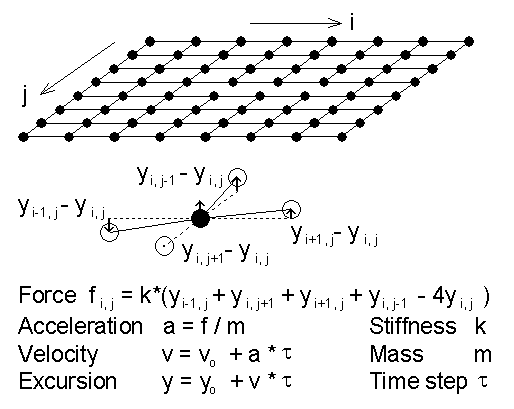 For
those math interested, the basic simulation procedure is illustrated in
attached 'pipegrid.gif'. A wave propagation plane is constructed from a
50*100 grid of little masses, length and width indexed with coordinates
i and j. Each mass point can move up/down with an excursion y
(which represents sound pressure at this point) and is connected to its
4 closest neighbors with little springs. The simulation is a 'time
stepping' operation - knowing the current positions y(i,j) of those
5000 masses, you compute what will their new positions be after a short
time interval (tau). This is done in three steps:
For
those math interested, the basic simulation procedure is illustrated in
attached 'pipegrid.gif'. A wave propagation plane is constructed from a
50*100 grid of little masses, length and width indexed with coordinates
i and j. Each mass point can move up/down with an excursion y
(which represents sound pressure at this point) and is connected to its
4 closest neighbors with little springs. The simulation is a 'time
stepping' operation - knowing the current positions y(i,j) of those
5000 masses, you compute what will their new positions be after a short
time interval (tau). This is done in three steps:
